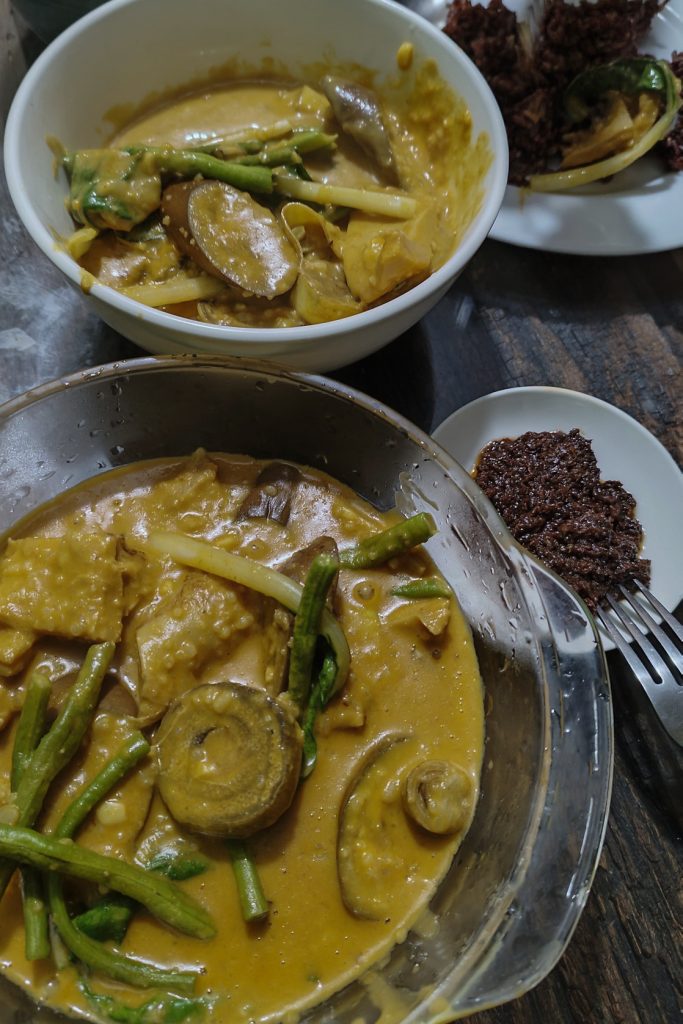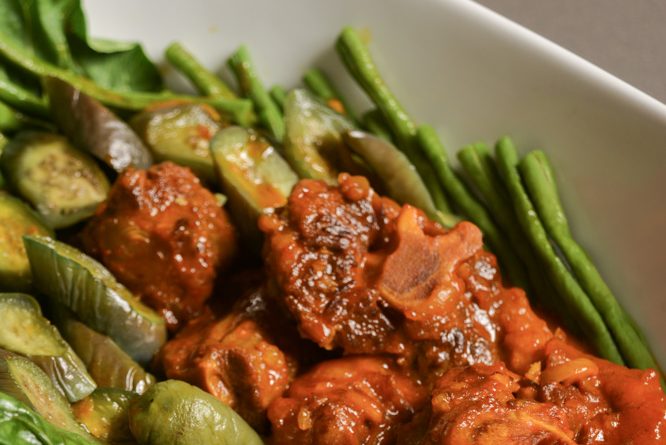In order to determine the precise origin of a Filipino food, one can examine the nation’s history of trade and colonization as potential indicators. This encompasses the influence of Chinese merchants, the Spanish colonial government, and the American power, among other factors. It is widely accepted that Filipino food is a combination of several cultural influences, and this is also true for the immensely popular dish that has an intriguing history. The origin of this traditional meal can be traced back to the period of British invasion of Manila from 1762 to 1764, when it is thought to have been brought to the Philippines. It’s called “kari-kari.”
First seeing this dish would make you assume it’s an Indian curry. Well, it is. According to Encyclopedia Britannica, the word kari, which is from Tamil and called curry in English, means “sauce.” In Western usage, it’s a dish composed with a sauce or gravy seasoned with a mixture of ground spices is thought to have originated in India and has since spread to many regions of the world. There is also a dish in Kerala , a Southwestern state of India, called “kaikaari,” which means a soup mixed with different types of vegetables.
Under the leadership of General Draper, the British expedition against Spanish forces in the Philippines departed from Fort St. George in Madras, which is now the current city of Chennai in India. Manila was occupied with minimal violence and effort in 1762. Among the expeditionary force were nearly 1400 laborers and over 800 Indian Sepoys. But the British occupation was only momentary.
In March 1764, orders were brought from both the King of Britain and the King of Spain by the Spanish governor, Brigadier Don Francisco de la Torre, requiring the handover of the city to Spain by the 1763 Treaty of Paris.
When the British troops withdrew in 1764, the Sepoy soldiers were left behind and settled in the towns of Cainta and Taytay. They established curry food stalls in the area. Tagalogs called the dish kari (curry) and the food stalls karihan. The hispanized form of karihan was carinderia. Eventually, carinderias served other dishes aside from curry.

Prof. Nestor Castro from the University of the Philippines conducted an ethno-archaeological study titled “Pagkilala sa mga Magpapalayok: Ang Kaso ng Palayukan sa Pasig(2021)”. In his research, he identified a specific type of clay pot called “kari” that is used for cooking kari-kari:
“May tatlong klase ng palayok ang kanilang ginagawa: ang saingan, sigangan, at kari. Ang saingan ay ang mabilog na palayok na karaniwang ginagamit sa pagluluto ng kanin. Sigangan naman ang tawag sa palayok na lapat ang ilalim at karaniwang ginagamit sa pagluluto ng karne at gulay. Tinatawag namang kari ang maliit na palayok na ginagamit din sa pagluluto ng mga ulam.”
In an entry in the book entitled Diccionario de Filipinismos Con La Revision de Lo Que al Respecto Lleva Publicado La Real Academia Española by Wenceslao E. Retana, published in Paris, France, 1921, he mentioned a citation by Blumentriit quoting Pardo De Tavera about the word “cari”:
Spanish:
“Cari Guiso, hecho con camarones y salsa picante. Originario de la India inglesa. “Muy estimado de los indios de Filipinas y de los europeos, tónico y útil para los países tropicales, ha llegado a inscribirse en los menus más escogidos de la cocina francesa y sobre todo la inglesa.”
—PARDO DE TAVERA, citadopor BLUMENTRITT.
Translation:
“Cari is a dish made with shrimp and spicy sauce. Originally from British India. “Highly esteemed by the Indios of the Philippines and Europeans as a tonic and useful for tropical countries, it has come to be included in the most selected menus of French cuisine, and especially English.”
—PARDO DE TAVERA, cited by BLUMENTRITT.
On the other hand, the word carinderia was also mentioned as an entry in the dictionary.
Spanish:
CARINDERÍA: Local donde se hace y vende cari. A las orillas del Pásig y de todos los ríos, hay infinidad de CarinderÍas, edificadas, la mitad sobre tierra, la mitad sobre el río, destinadas a servir más principalmente a los banqueros.”
—P. DE TAVERA, citado por BLUMENTRITT.
Translation:
“CARINDERÍA: The local stalls, where cari is made and sold. On the banks of the Pasig and all the rivers, there are countless CARINDERÍAS, built, half on land, half on the river, intended to serve more primarily the boatmen.”
—P. DE TAVERA, cited by BLUMENTRITT.
A book published in Madrid, Spain entitled In the book El Practicon by Angel Muro mentioned a Filipino food named Kari de Salsa., which he wrote as a popular dish in the Philippines:
Spanish:
He sacado á relucir el kari antes de tiempo, y tengo que decir lo que es y cómo se hace, pues es p ato muy conocido en España y muy en uso entre la gente que ha estado en Filipinas, por ser manjar de allá. El kairi es una preparación culinaria que debemos a los Indios.
-ANGEL MURO
Translation:
The kari is a flavorful dish that originated in the Philippines and has become popular in Spain. It is a delicacy that is enjoyed by many, especially those who have had the opportunity to visit the Philippines. The preparation of kari involves a unique blend of spices and ingredients that give it its distinct taste. It is a dish that we owe to the people of the Philippines, as they have perfected this culinary creation over generations.
-ANGEL MURO
But the kari-kari of today may not be similar to the kari-kari of the Sepoys, who have descendants that were a result of intermarrying with the locals. The contemporary kari-kari is made up of ground peanuts mixed with rice, vegetables, and beef, something that is forbidden in Indian culture. The indigenized version even added shrimp paste as a salty side dish that complements the sweetness of the peanut sauce and flavorful beef meat.
In 1916, a book called “Kusinang Tagalog ng Aklatan at Limbagan” by P. Sayo Balo ni Soriano mentioned a dish called “Cari.” The recipe in the book included ground peanuts combined with an equal amount of rice, which would be used as the sauce. The sauce is enhanced with annatto oil extract to provide color. The meat consists of tripe, beef chunks, and oxtail, accompanied by vegetables such as eggplants, string beans, hyacinth beans, and other desired vegetable additions. Comparable to the contemporary kari-kari, it uses shrimp paste or what is locally known as “bagoong”.
The evolution of kari-kare in the Philippines reflects the fusion of Indian and Filipino culinary traditions. Over time, the dish has adapted to local tastes and ingredients, resulting in a unique and distinct flavor profile. Today, kari-kare continues to be a beloved dish in Filipino cuisine, showcasing the rich history and cultural exchange between the Indians and the local communities, brought about by a very brief British occupation.
SOURCES:
-Felice Sta.Maria, Kare-Kare, Vignettes, Facebook Timeline Post. Accessed: August 2022
-Professor Nelson Castro, Ph.D. Kare Kare. Facebook Timeline Post. Accessed: February 2021.
Archival Sources:
-Soriano, P. Sayo Balo ni. Kusinang Tagalog Ng Aklatan at Limbagan. Book. 1st Edition. Manila, Pampanga, Philippines: Aklatan at Limbagan ni P. Sayo Balo ni Soriano, 1916.
-Muro, Angel. Diccionario Heneral De Cocina/ Ilustrado Con Comos De Lujo. Book. Madrid, Spain, 1892.
-Retana, Wenceslao. Diccionario de Filipinismos Con La Revision de Lo Que al Respecto Lleva Publicado La Real Academia Española. Paris, France, 1921.
-Foreman, John. The Philippine Island. London, UK, 1890.
-Larkin, John. The Pampangans: Colonial Society in a Philippine Province. Book. Reprint Edition. Quezon, Pampanga, Philippines: New Day Publishers, 1993.
-REGALA-ANGANGCO, OFELIA, and ADELISA ALMARIO, “THE INDIAN COMMUNITY IN THE PHILIPPINES.” Philippine Sociological Review 6, no. 2 (1958): 10–24. http://www.jstor.org/stable/43498034.
Multimedia Sources:
-Kari-Kare photo by Ruston Banal, 2022
-Heirloom recipe of Jap Quiroz Cruz.
-Carinderia, by Jose Lozano, 1847
